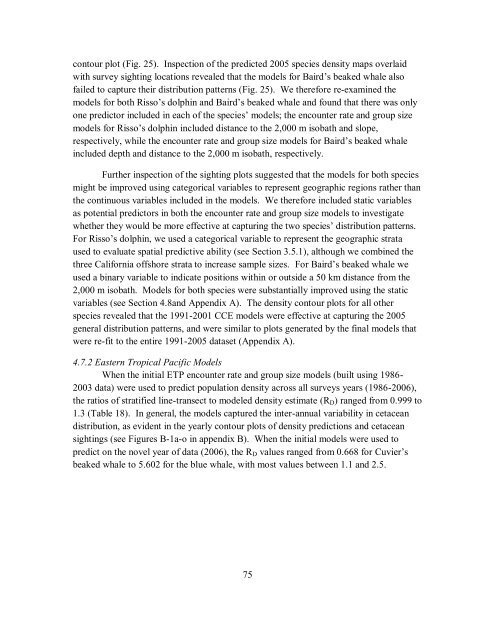Final Technical Report: - Southwest Fisheries Science Center - NOAA
Final Technical Report: - Southwest Fisheries Science Center - NOAA
Final Technical Report: - Southwest Fisheries Science Center - NOAA
Create successful ePaper yourself
Turn your PDF publications into a flip-book with our unique Google optimized e-Paper software.
contour plot (Fig. 25). Inspection of the predicted 2005 species density maps overlaid<br />
with survey sighting locations revealed that the models for Baird’s beaked whale also<br />
failed to capture their distribution patterns (Fig. 25). We therefore re-examined the<br />
models for both Risso’s dolphin and Baird’s beaked whale and found that there was only<br />
one predictor included in each of the species’ models; the encounter rate and group size<br />
models for Risso’s dolphin included distance to the 2,000 m isobath and slope,<br />
respectively, while the encounter rate and group size models for Baird’s beaked whale<br />
included depth and distance to the 2,000 m isobath, respectively.<br />
Further inspection of the sighting plots suggested that the models for both species<br />
might be improved using categorical variables to represent geographic regions rather than<br />
the continuous variables included in the models. We therefore included static variables<br />
as potential predictors in both the encounter rate and group size models to investigate<br />
whether they would be more effective at capturing the two species’ distribution patterns.<br />
For Risso’s dolphin, we used a categorical variable to represent the geographic strata<br />
used to evaluate spatial predictive ability (see Section 3.5.1), although we combined the<br />
three California offshore strata to increase sample sizes. For Baird’s beaked whale we<br />
used a binary variable to indicate positions within or outside a 50 km distance from the<br />
2,000 m isobath. Models for both species were substantially improved using the static<br />
variables (see Section 4.8and Appendix A). The density contour plots for all other<br />
species revealed that the 1991-2001 CCE models were effective at capturing the 2005<br />
general distribution patterns, and were similar to plots generated by the final models that<br />
were re-fit to the entire 1991-2005 dataset (Appendix A).<br />
4.7.2 Eastern Tropical Pacific Models<br />
When the initial ETP encounter rate and group size models (built using 1986-<br />
2003 data) were used to predict population density across all surveys years (1986-2006),<br />
the ratios of stratified line-transect to modeled density estimate (RD) ranged from 0.999 to<br />
1.3 (Table 18). In general, the models captured the inter-annual variability in cetacean<br />
distribution, as evident in the yearly contour plots of density predictions and cetacean<br />
sightings (see Figures B-1a-o in appendix B). When the initial models were used to<br />
predict on the novel year of data (2006), the RD values ranged from 0.668 for Cuvier’s<br />
beaked whale to 5.602 for the blue whale, with most values between 1.1 and 2.5.<br />
75









